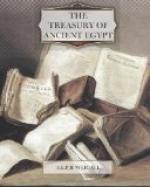[Illustration: PL. XVIII. The entrance
of the tomb of Queen Tiy, with
Egyptian
policeman standing beside it. On
the
left is the later tomb of Rameses X.]
[Photo by R. Paul.
To pass this portion of the shrine which lay in the passage without doing it damage was no easy matter. We could not venture to move it, as the wood was rotten; and indeed, for over a year it remained in its original position. We therefore made a bridge of planks within a few inches of the low roof, and on this we wriggled ourselves across into the unencumbered passage beyond. In the funeral-chamber, besides the other portions of the shrine, we found at one corner a splendid coffin, in the usual form of a recumbent figure, inlaid in a dazzling manner with rare stones and coloured glass. The coffin had originally lain upon a wooden bier, in the form of a lion-legged couch; but this had collapsed and the mummy had fallen to the ground, the lid of the coffin being partly thrown off by the fall, thus exposing the head and feet of the body, from which the bandages had decayed and fallen off. In the powerful glare of the electric light which we carried, the bare skull, with a golden vulture upon it, could be seen protruding from the remains of the linen bandages and from the sheets of flexible gold-foil in which, as we afterwards found, the whole body was wrapped. The inscription on the coffin, the letters of which were made of rare stones, gave the titles of Akhnaton, “the beautiful child of the Sun”; but turning to the shrine we found other inscriptions stating that King Akhnaton had made it for his mother, Queen Tiy, and thus no immediate reply could be given to those at the mouth of the tomb who called to us to know which of the Pharaoh’s of Egypt had been found.
In a recess in the wall above the body there stood four alabaster “canopy” jars, each with a lid exquisitely sculptured in the form of a human head. In another corner there was a box containing many little toilet vases and utensils of porcelain. A few alabaster vases and other objects were lying in various parts of the chamber, arranged in some sort of rough order.




